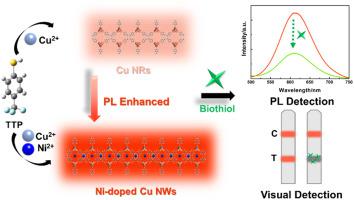Sensors and Actuators B: Chemical ( IF 8.4 ) Pub Date : 2021-09-20 , DOI: 10.1016/j.snb.2021.130777 Ailing Han 1 , Xiaoyu Luo 1 , Sijia Hao 1 , Yayu Yang 1 , Jianan Chen 1 , Guozhen Fang 1 , Jifeng Liu 1 , Shuo Wang 1, 2

|
Copper nanoribbons (Cu NRs) and Ni-doped copper nanowires (Cu NWs) with red photoluminescent (PL) were prepared and employed for detection of biothiol. Using 4-(trifluoromethyl) thiophenol as both reducing agent and protecting ligand, the copper nanoclusters (Cu NCs) were synthesized and assembled to nanoribbons. And the Cu NCs were assembled to nanowires by adding nickel ion precursor in synthetic process. The Cu NWs with 3% Ni doping showed a 3-fold emission enhancement than Cu NRs, and the absolute quantum yield was obviously increased from 4.53% to 19.76%. The doped Ni induced Ni-Cu metallophilic interaction, which facilitated the radiative relaxation of excited electrons and furtherly resulted in stronger PL emitting. The morphologies, composition, electronic states, geometrical configuration and arrangement of Cu NCs in assembled architecture were studied by experimental and theoretical investigation. Moreover, the PL of Cu NCs assembly was sensitive to cysteine, homocysteine, and glutathione attributed to surface ligands exchange of Cu NCs through interaction between metal and sulfydryl group. Therefore, a rapid, sensitive, and selective sensing strategy for detection of biothiol was proposed. And the PL test strips based on Cu NCs assembly were fabricated for visual detection of biothiol. Finally, the practical application of sensing system and PL test strips were verified in fetal bovine serum samples spiked with cysteine and homocysteine.
中文翻译:

红色光致发光镍掺杂自组装铜纳米团簇的合成及其在生物硫醇传感中的应用
制备了具有红色光致发光 (PL) 的铜纳米带 (Cu NRs) 和 Ni 掺杂的铜纳米线 (Cu NWs) 并用于检测生物硫醇。使用 4-(三氟甲基) 苯硫酚作为还原剂和保护配体,合成了铜纳米簇 (Cu NCs) 并组装成纳米带。并且在合成过程中通过添加镍离子前驱体将Cu NCs组装成纳米线。具有 3% Ni 掺杂的 Cu NWs 显示出比 Cu NRs 的 3 倍发射增强,绝对量子产率明显从 4.53% 增加到 19.76%。掺杂的 Ni 诱导 Ni-Cu 亲金属相互作用,这促进了激发电子的辐射弛豫,并进一步导致更强的 PL 发射。形态、组成、电子状态、通过实验和理论研究,研究了组装结构中 Cu NCs 的几何构型和排列。此外,Cu NCs 组装的 PL 对半胱氨酸、高半胱氨酸和谷胱甘肽敏感,这归因于 Cu NCs 通过金属和巯基之间的相互作用进行表面配体交换。因此,提出了一种快速、灵敏、选择性检测生物硫醇的传感策略。并制作了基于 Cu NCs 组件的 PL 测试条,用于生物硫醇的视觉检测。最后,在添加半胱氨酸和同型半胱氨酸的胎牛血清样品中验证了传感系统和 PL 试纸的实际应用。和谷胱甘肽归因于通过金属和巯基之间的相互作用,Cu NCs 的表面配体交换。因此,提出了一种快速、灵敏、选择性检测生物硫醇的传感策略。并制作了基于 Cu NCs 组件的 PL 测试条,用于生物硫醇的视觉检测。最后,在添加半胱氨酸和同型半胱氨酸的胎牛血清样品中验证了传感系统和 PL 试纸的实际应用。和谷胱甘肽归因于通过金属和巯基之间的相互作用,Cu NCs 的表面配体交换。因此,提出了一种快速、灵敏、选择性检测生物硫醇的传感策略。并制作了基于 Cu NCs 组件的 PL 测试条,用于生物硫醇的视觉检测。最后,在添加半胱氨酸和同型半胱氨酸的胎牛血清样品中验证了传感系统和 PL 试纸的实际应用。



























 京公网安备 11010802027423号
京公网安备 11010802027423号